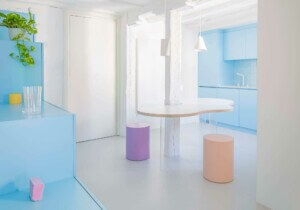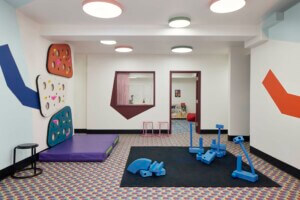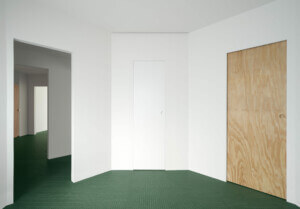“We built the walls of this school together, men and women, because we wanted it to be new and different for our children.”
—the people of Villa Cella, Reggio Emilia, May 1945
After weaving through the streets of Madrid’s El Encinar de los Reyes neighborhood, learners arrive at the Highlands Colegio, a private Catholic academy in a nondescript orthogonal brick building. Students are called over a loudspeaker and run to class in their blue uniforms: suits for the boys and skirts for the girls. Just beyond the school, however, is something completely different: A yellow, spaceship-like tower with a variety of windows, arches, sawtooth roofs, and concrete platforms rises in the distance. That building is the Reggio School, designed by the Office for Political Innovation (OFFPOLINN), a practice led by Andrés Jaque, with offices in Madrid and New York.
This contrast couldn’t be any clearer. The architectural difference highlights Reggio’s place in the long history of progressive school design and the quest to provide better learning environments through architecture.
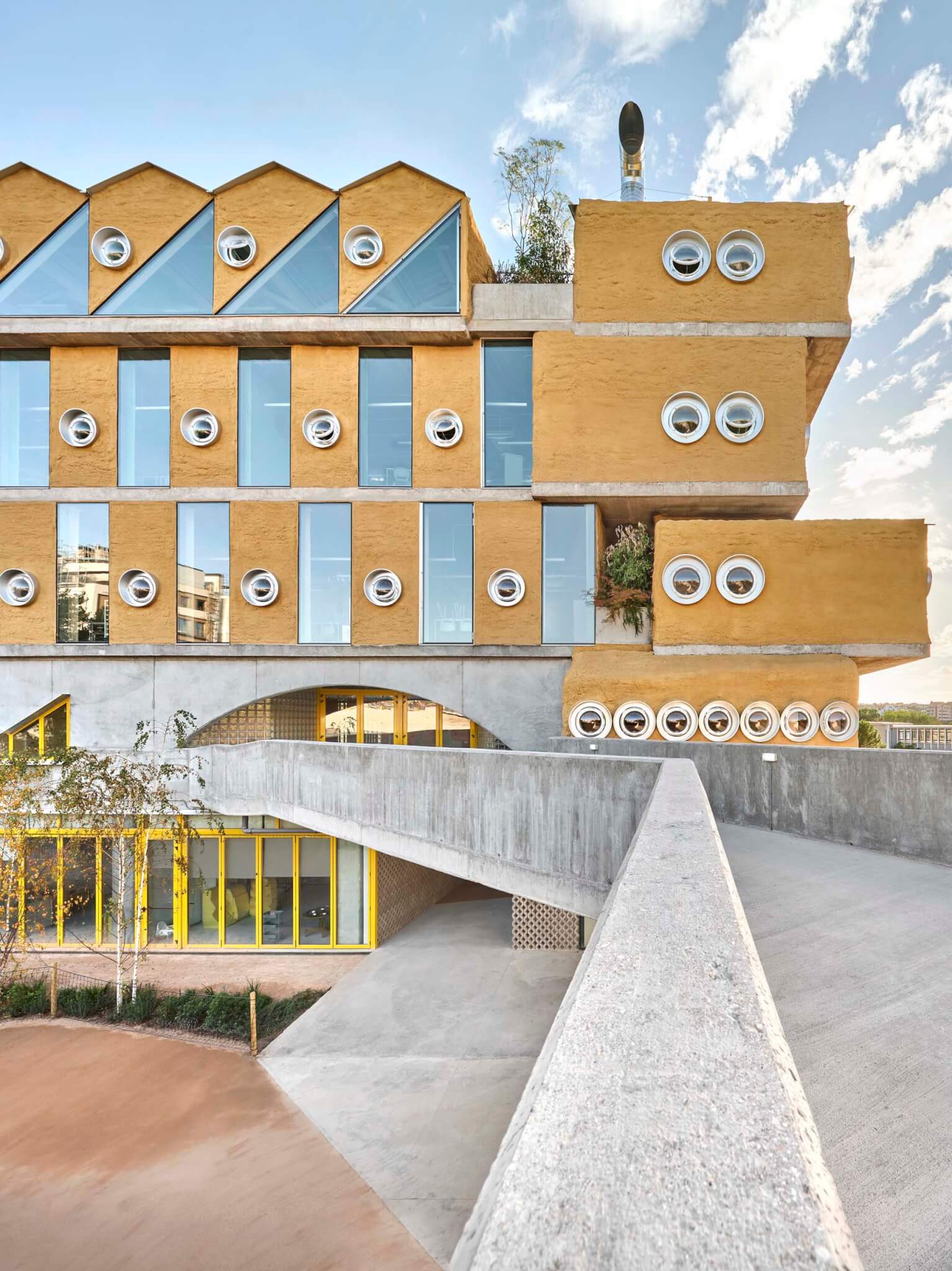
Madrid’s Reggio School program is based on the Reggio Emilia philosophy, a nonhierarchical, cooperative learning style born in 1945 in the wake of the destruction of Italy during World War II. In the region of Emilia-Romagna, the radical leftist Italian Women’s Union built its own cooperative schools in bombed-out buildings. The Reggio Emilia pedagogy—a fresh start after Fascism destroyed the education system—eschews hierarchical information transfer in favor of self-development, communication, and encounters.
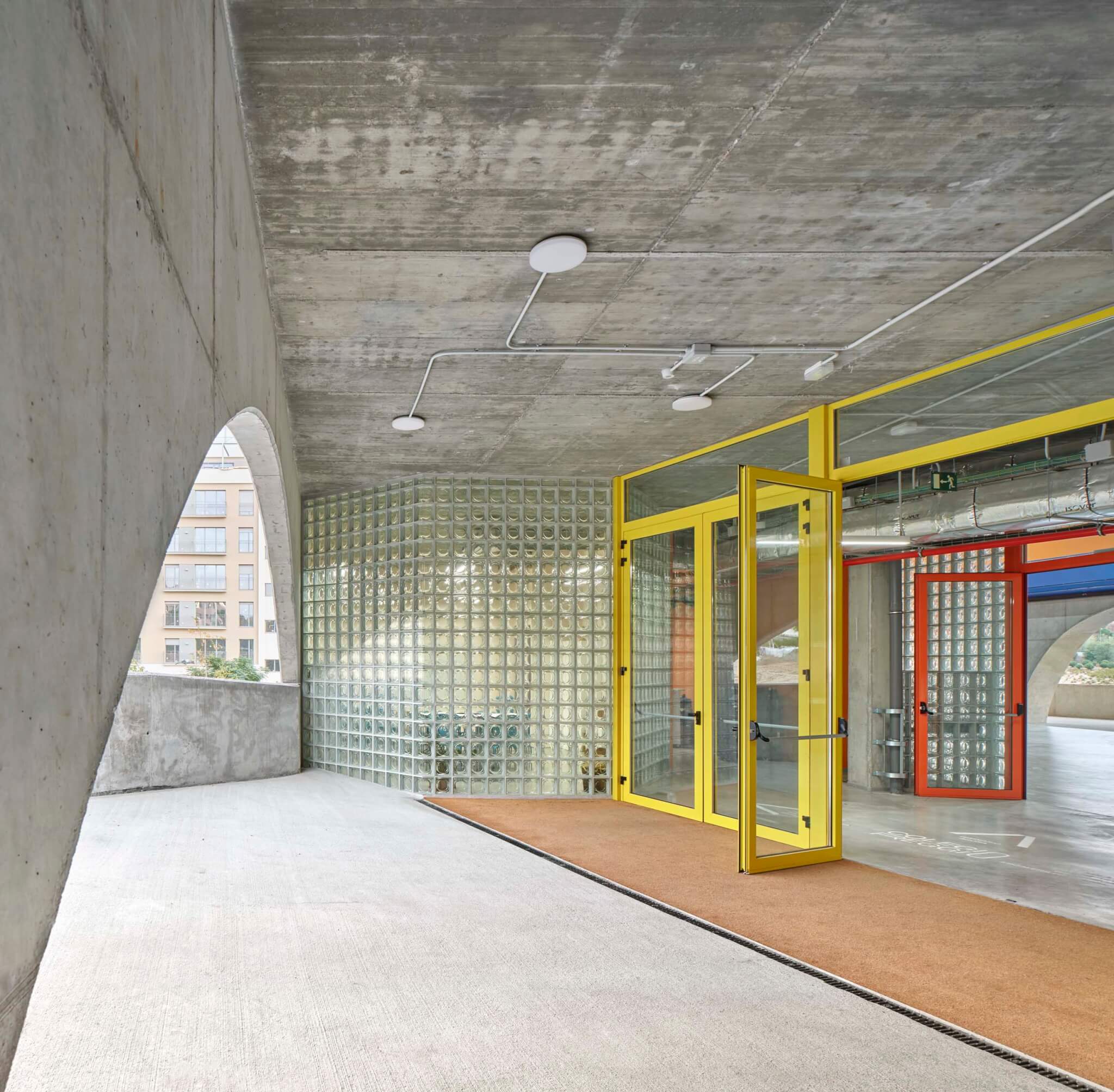
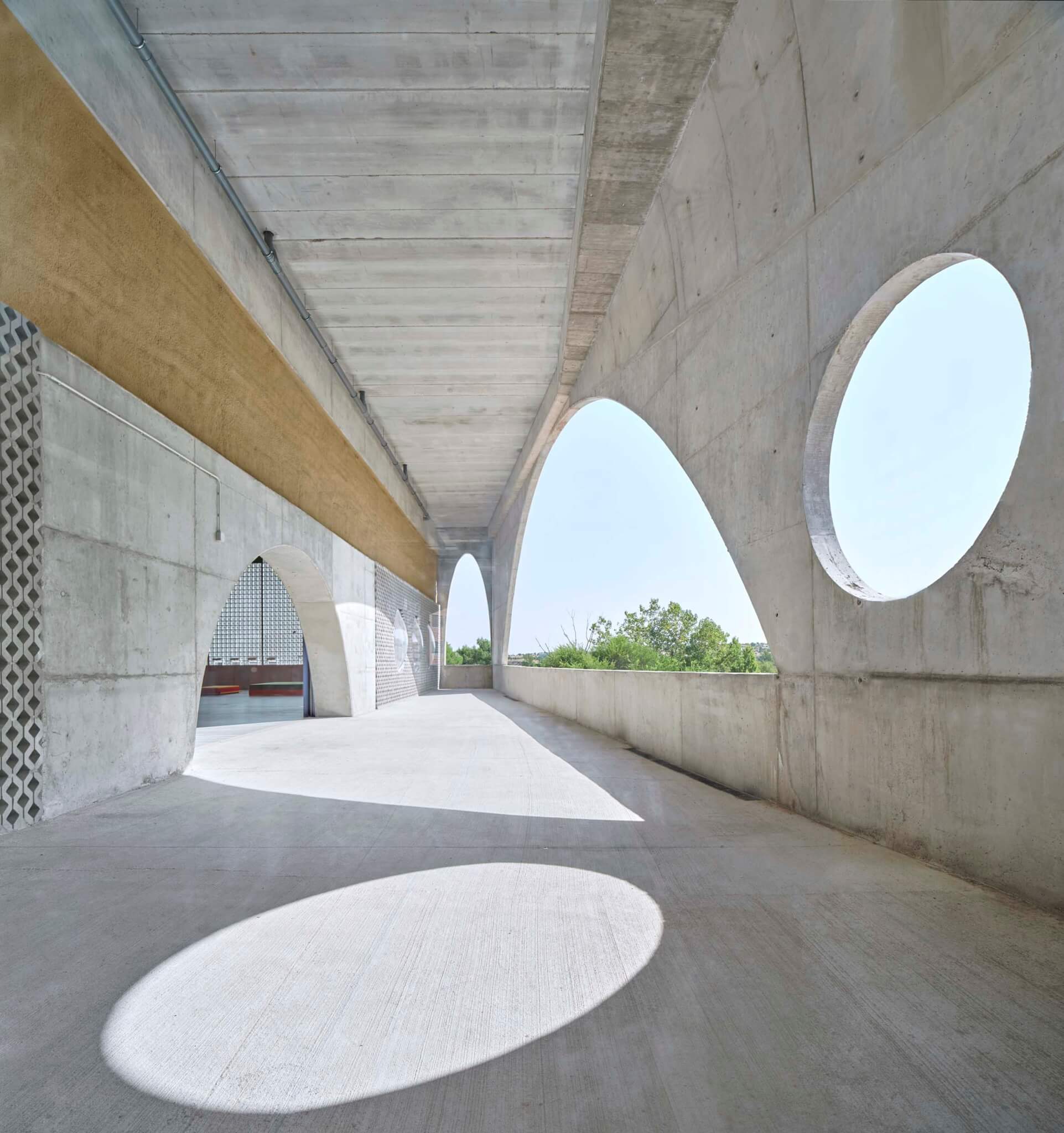
As part of this philosophy, the school environment is considered the “third teacher,” in addition to human instructors and other children. Like its modernist predecessors, the architecture of the Reggio School is meant to give children a better learning environment to “arouse in children a desire for exploration and inquiry,” according to a project description by OFFPOLINN.
The Reggio School in Madrid seeks to foster this interaction through its near elimination of hallways, a move that results in students of all ages wandering through different classrooms or entering rooms directly from communal spaces such as the cafeteria. The scheme follows in the lineage of early modernist and Functionalist plans that were less formally rigid and more functionally expressive than the strict plans of their Beaux Arts predecessors. Both Wright’s Hillside Home School II at Taliesin (1901) and Hannes Meyer and Hans Wittwer’s German Trade Union School (1930) are examples of this impulse, as they reorganized the school with carefully designed arrangements of classrooms, connections to nature, and specialized common areas such as cafes, gymnasiums, and auditoriums.
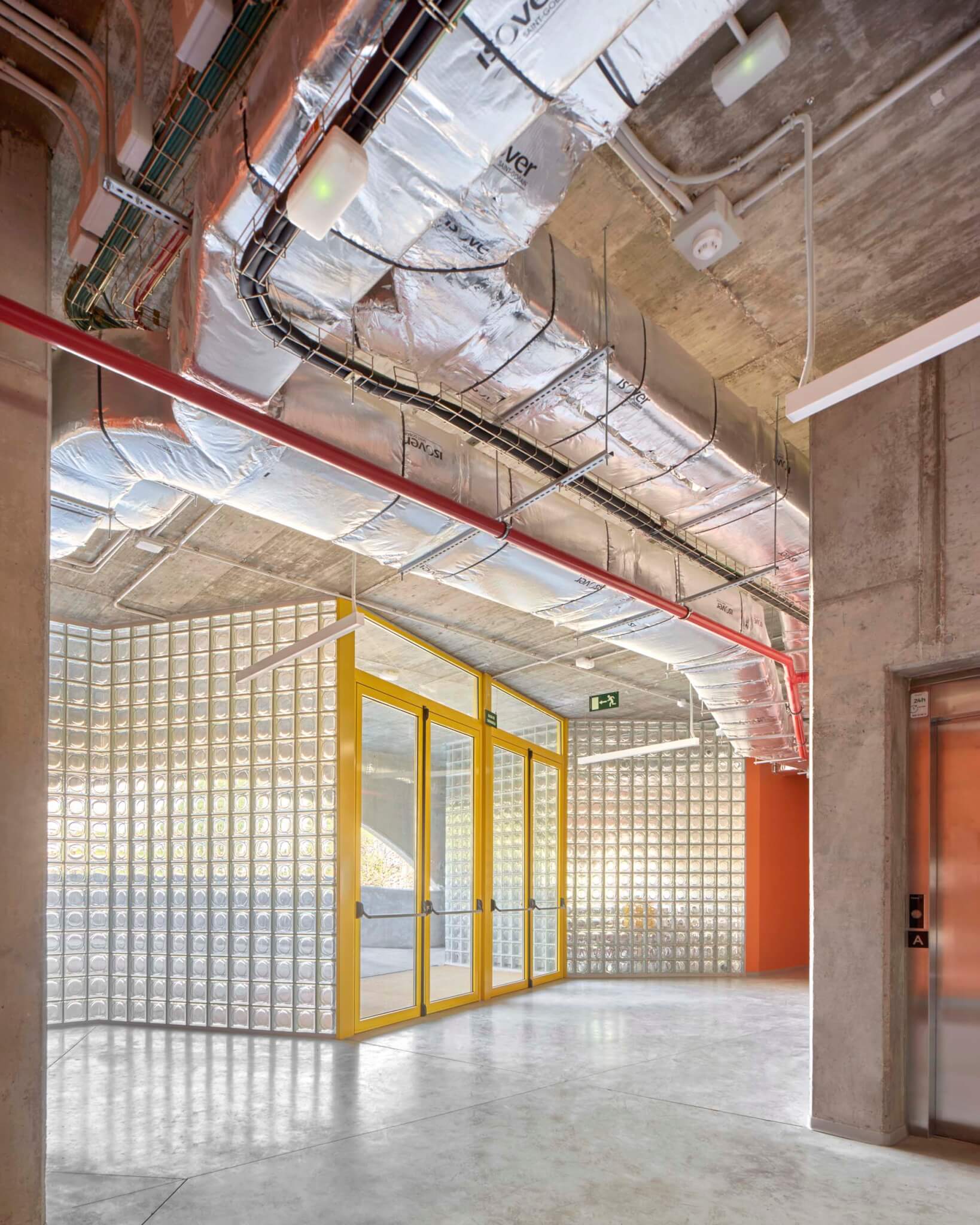
This modernist idea of freeing schools (in plan) from institutional rigidity would continue through the 1960s and 1970s with later progressive movements such as Hertzberger’s eclectic, flexible designs for the Montessori system of interactive, self-directed learning, or the open-school concept, which attempted to almost completely eliminate walls to foster communication and interaction among students of all levels. Open-concept school buildings are exemplified by Hardy Holzman Pfeiffer’s Mt. Healthy Elementary School (1972) in Columbus, Indiana, which to this day has retained its open classroom clusters with most of the original architecture intact.

At Reggio, the question “Is having another class of students walking through a science lab a good idea?” is an important part of an ongoing experiment in which the plan acts as a social organizer within the pedagogical ambitions of a given school.
In section, the Reggio’s programmatic reorganization is heightened in the central atrium space, “a more-than-human assembly at the school’s heart,” Jaque told AN on a visit to the school in January. Here the architects employ a vertical organization system they describe as “the stacking of diversity as an environment for self-education.” Younger students are located on the ground floor, with older students on floors above, a strategy that recalls the Indian Community School (2007) in Milwaukee by Antoine Predock with collaborating designer Chris Cornelius. At Reggio, water and soil tanks are placed alongside circulation paths, and an indoor garden acts as a gathering space as well as a natural ecosystem within the building—a nonhuman classmate.
Fostering a connection to nature via outdoor courtyards, walkways, and play areas has long been a theme in modern school design, especially in the work of California architects like Richard Neutra and John Carl Warnecke. Madrid’s Reggio school brings the outside in to create a triple-height indoor landscape that acts as a central community space; it’s a combination courtyard-atrium, and, notably, both were common elements in modernist school design.

It is not all fun and games. One of the biggest challenges in school design is cost. Reggio was built cheaply at an overall cost of about $9 million. While the average price per square foot for schools in Spain is about $162 per square foot, Reggio landed at about $120 per square foot. In the 21st century, environmental challenges can further complicate school budgets, but Jaque and OFFPOLINN took it as an opportunity for clever experimentation. At Reggio, they call their strategy “thinning, skinning, and make fluffy.”
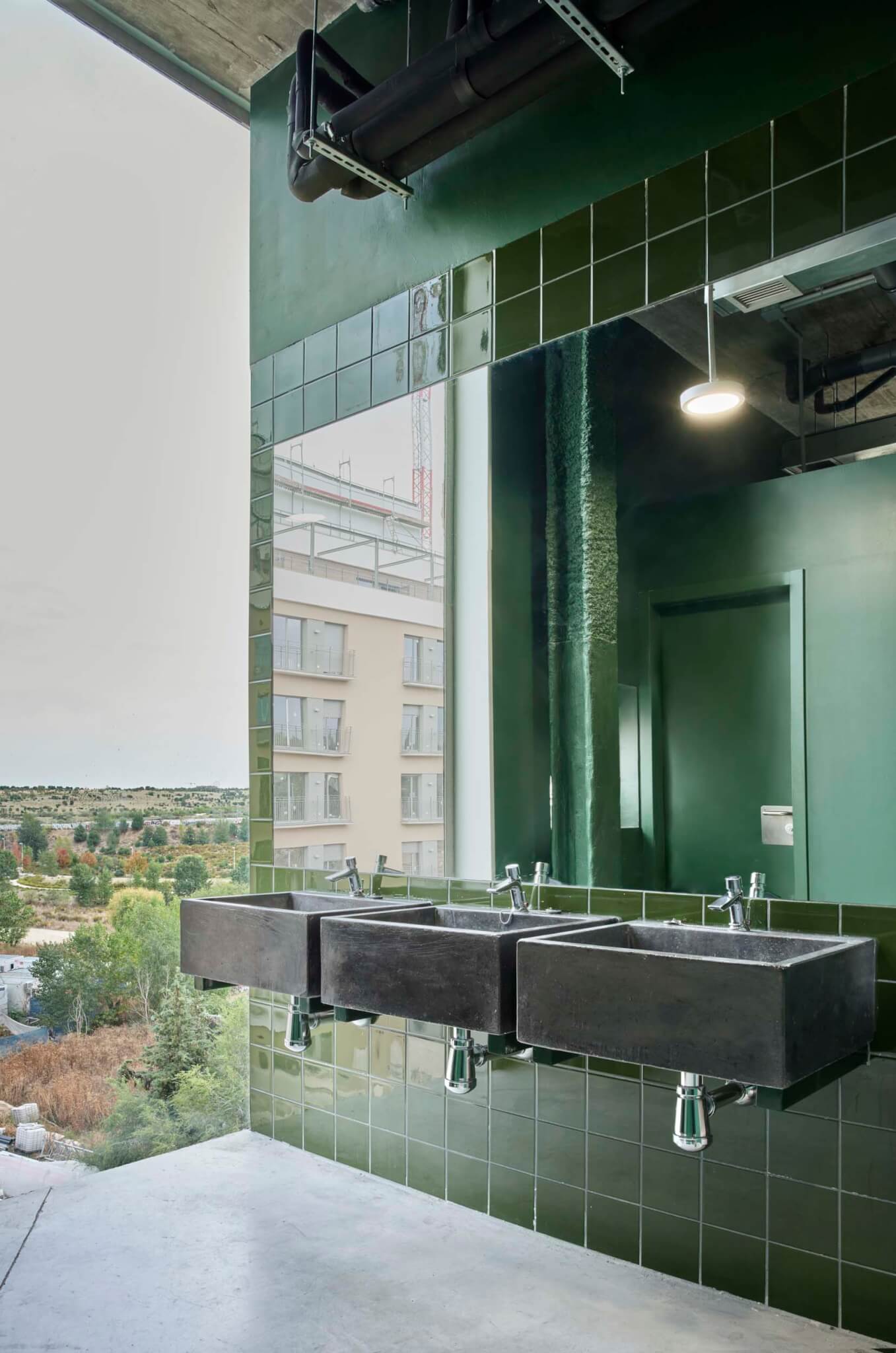
Using less material (“thinning”) meant reducing the amount of concrete through close collaboration with the structural engineer, eliminating 33 percent of the embodied energy in the structure. Taking off cosmetic materials (“skinning”) such as wallcoverings, drop ceilings, and raised flooring, OFFPOLINN created a new aesthetic of “nakedness,” exposing systems as much as possible. On the exterior, a special cork insulation developed by OFFPOLINN was sprayed on (“make fluffy”). It gives the building its unique coloring, as well as double the R-value required by local code, and saves money both pre- and postoccupancy. And the rough surface of the cork insulation is expected to grow its own ecosystem with fungi, plants, and animals. Clever use—or nonuse—of materials has long been a tenet of modernist school design, often to exciting ends. The Architects Collaborative, led by Walter Gropius and Norman Fletcher, designed its “Universal School” in 1954 as a thought experiment for Collier’s magazine. Composed of any number of square pavilions made of prefabricated materials, the modular system could be economically built and endlessly customized. The colorful metal tubes at John Johansen’s Smith Elementary School (1969) in Columbus are made of painted metal farm sheds. Similarly, at Reggio, the building’s aesthetic—both the “naked” interior and the “fluffy” exterior—comes from solutions required by economy. OFFPOLINN also employed several cheap materials that are not “fashionable,” yet give the school its distinctive aesthetics. Glass blocks, stone sinks from artisans in a nearby village, and circular windows used in camper van conversions are all off-the-beaten-path materials that break from the everyday school building palette.
The design decisions are part of a holistic strategy: Expose and express systems to give students awareness of those systems and their relationships to them. This includes learning about mechanical and structural systems, but also ecological systems and even social and political systems. The classrooms’ adjacencies to nature and common spaces are more intertwined than in a typical school, forcing students to take part in the “public” aspects of the school’s community and teaching them lifelong skills about societal participation.
Jaque’s conceptualization of the school building as “naked” resonates with the over-articulation of program in what critic R. Thomas Hille called the “associational” schools of German architect Hans Scharoun, who developed several designs for schools that would simulate a democratic society by grouping classrooms in levels, or neighborhoods, along a public “street” corridor. For Jaque, however, this over-articulation is not only programmatic but also used to expose building systems and integrate nature in an almost mannerist way. The end goal is the same: to foster a sense of connection between students and the outside world, both natural and social.

This idea of school as a model society isn’t fully formed in its site plan and relationship to the neighborhood. The connection to the adjacent linear park is not yet clear, as the park is currently being planned by OFFPOLINN’s team, and the school’s landscaping is not fully grown. A large concrete slab will likely be augmented with some more hospitable plantings, furniture, or paint that will invite the community in. OFFPOLINN’s hypnotic, almost dizzying rhetoric might seem needlessly academic, but it ultimately checks out when touring the work it generates. In fact, the ideas become part of the building’s lore, adding a layer of inspiration and enchantment to the school itself.
In 2023, it is rare to see a building that actually innovates in program, material, or ecological strategy, let alone all three. The Madrid Reggio School does this in a way that aligns with the best intentions and examples of modernism. Schools are often the first place that impressionable students encounter architecture, and these environments can be formative when embracing a life of learning, exploration, and self-education. If that’s the role of a school building, then the Reggio School in Madrid stands to play it beautifully.
Matt Shaw is a New York–based columnist and author of the forthcoming book American Modern: Architecture Community Columbus Indiana.







